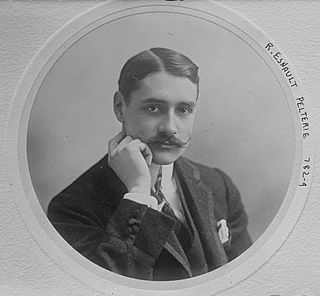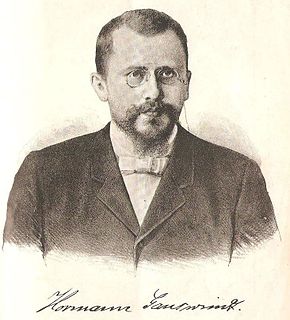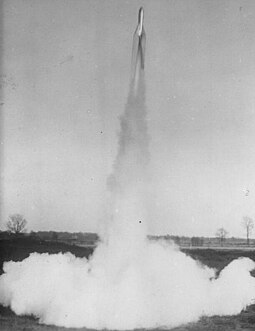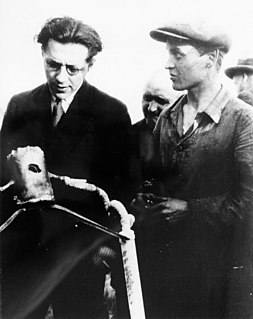Related Research Articles

Hermann Julius Oberth was an Austro-Hungarian-born German physicist and engineer. He is considered one of the founding fathers of rocketry and astronautics, along with the French Robert Esnault-Pelterie, the Russian Konstantin Tsiolkovsky, and the American Robert Goddard.

Max Valier was an Austrian rocketry pioneer. He helped found the German Verein für Raumschiffahrt that would bring together many of the minds that would later make spaceflight a reality in the 20th century.
The Verein für Raumschiffahrt was a German amateur rocket association prior to World War II that included members outside Germany. The first successful VfR test firing with liquid fuel was conducted by Max Valier at the Heylandt Works on January 25, 1930; and additional rocket experiments were conducted at a farm near Bernstadt, Saxony.

Eugen Sänger was an Austrian aerospace engineer best known for his contributions to lifting body and ramjet technology.

Project Daedalus was a study conducted between 1973 and 1978 by the British Interplanetary Society to design a plausible uncrewed interstellar spacecraft. Intended mainly as a scientific probe, the design criteria specified that the spacecraft had to use existing or near-future technology and had to be able to reach its destination within a human lifetime. Alan Bond led a team of scientists and engineers who proposed using a fusion rocket to reach Barnard's Star 5.9 light years away. The trip was estimated to take 50 years, but the design was required to be flexible enough that it could be sent to any other target star.
In spaceflight, an orbital maneuver is the use of propulsion systems to change the orbit of a spacecraft. For spacecraft far from Earth an orbital maneuver is called a deep-space maneuver (DSM).
The Berthold Seliger Forschungs- und Entwicklungsgesellschaft mbH (BSFEGmbH) was a company founded by German rocket technical designer Berthold Seliger in 1961. Seliger was a former assistant theoretician professor Dr. Eugen Sänger. The company developed and built prototypes of sounding rockets and launched them near Cuxhaven. The BSFEGmbH cooperated strongly with the Hermann-Oberth-Gesellschaft, of which Berthold Seliger was a member. The first rocket developed by the BSFEGmbH was an improved version of the Kumulus, which was first launched on 19 November 1962 and reached a height of 50 kilometres. On 7 February 1963 the BSFEGmbH launched a two-stage rocket with a maximum height of 80 kilometres and, on 2 May 1963, they launched a three-stage rocket with a maximum flight height of more than 100 kilometres. The latter rocket may have attained the highest flight altitude of all rockets built in post-war Germany. The signals from all these rockets were also received at the observatory in Bochum. After May 1963 the BSFEGmbH worked on the improvement of the steering system of their rockets and thought also on military usable rockets.
Kumulus is the name of a rocket of the "Hermann-Oberth-Gesellschaft e.V.". The first Kumulus rocket was launched on December 20, 1960 near Cuxhaven. A Kumulus rocket is on display at the Hermann Oberth Space Travel Museum in Feucht.
The Hermann Oberth Society is an association named after Hermann Oberth, the German astronautics pioneer and the authoritative expert on rocketry outside the United States, which develops and builds rockets and trains engineers in space technology.
Between 1933 and 1964 numerous rocket experiments were carried out in the area of Cuxhaven, Germany.

The Hermann Oberth Space Travel Museum is a museum of space technology in the Franconian city of Feucht in Bavaria, Germany.

Feucht is a market town and municipality southeast of Nuremberg in the Middle Franconia of Bavaria, Germany. The name Feucht is derived from the Old High German noun "viuhtje" - "fichta", which is the tree spruce. As of 31 July 2005, had a population of 13,590. Hermann Oberth (1894–1989), one of the early fathers of space travel, lived for many years and died in Feucht.

Robert Albert Charles Esnault-Pelterie was a French aircraft designer and spaceflight theorist. He is referred to as being one of the founders of modern rocketry and astronautics, along with the Russian Konstantin Tsiolkovsky, the German Hermann Oberth, and the American Robert H. Goddard.

Konrad Dannenberg was a German-American rocket pioneer and member of the German rocket team brought to the United States after World War II.

In astronautics, a powered flyby, or Oberth maneuver, is a maneuver in which a spacecraft falls into a gravitational well and then uses its engines to further accelerate as it is falling, thereby achieving additional speed. The resulting maneuver is a more efficient way to gain kinetic energy than applying the same impulse outside of a gravitational well. The gain in efficiency is explained by the Oberth effect, wherein the use of an engine at higher speeds generates greater mechanical energy than use at lower speeds. In practical terms, this means that the most energy-efficient method for a spacecraft to burn its engine is at the lowest possible orbital periapsis, when its orbital velocity is greatest. In some cases, it is even worth spending fuel on slowing the spacecraft into a gravity well to take advantage of the efficiencies of the Oberth effect. The maneuver and effect are named after the person who first described them in 1927, Hermann Oberth, an Austro-Hungarian-born German physicist and a founder of modern rocketry.

Hermann Ganswindt was a German inventor and spaceflight scientist, whose inventions are thought to have been ahead of his time.

SystemsGo is a program designed to promote the study of engineering and the development of work force skills. It encourages students to pursue careers in science, technology, engineering, and mechanics.

Reinhold Tiling was a German engineer, pilot and a rocket pioneer.

Otto Willi Gail was a German science journalist and author.

Paul Ehmayr was a German-Austrian rocket engineer. He was a precision mechanic. His masterpiece was a barometer.
References
- 1 2 Colin Burgess; Chris Dubbs (5 July 2007). Animals in Space: From Research Rockets to the Space Shuttle. Springer Science & Business Media. pp. 99–. ISBN 978-0-387-49678-8.
- ↑ Flight International. Illiffe Transport Publications. 1964.
| This rocketry article is a stub. You can help Wikipedia by expanding it. |